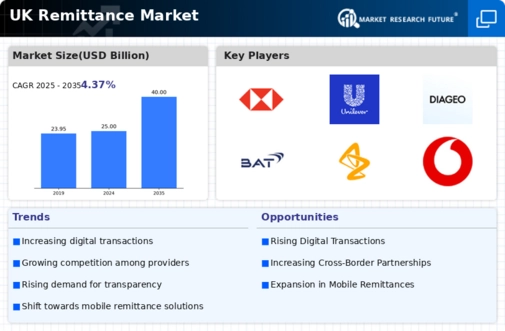The UK Remittance Market is characterized by a dynamic competitive landscape shaped by the evolving needs of consumers, regulatory changes, and technological advancements. The market is primarily driven by the growing number of immigrants as well as the increased demand for instantaneous and cost-effective money transfer solutions. As a result, various players have ventured into the remittance space, each striving to provide unique value propositions to remain competitive. Emerging fintech companies have leveraged digital technology to disrupt traditional payment methods, offering lower fees and faster transactions.
The competitive insights reveal a market that is continuously adapting to consumer trends, regulatory shifts, and innovative technologies, with companies aiming to cater to niche segments while enhancing customer experience and trust. Focusing on the strengths of Revolut within the UK Remittance Market, the company has established a prominent position through its innovative financial technology solutions that offer seamless and low-cost international money transfers. Revolut provides users with the capability to send money in multiple currencies at interbank exchange rates, thereby significantly reducing remittance costs compared to traditional banks.
Moreover, its user-friendly app and strong focus on customer experience have positioned Revolut as a favorite among tech-savvy individuals. The company's emphasis on continuous improvement and the introduction of features such as cryptocurrency support and budgeting tools contribute to its appeal. With increasing brand recognition, Revolut enjoys a robust user base and a strong presence in the UK market, allowing it to capitalize on the growing demand for efficient remittance services. Azimo, in the context of the UK Remittance Market, stands out as a key player emphasizing affordable and rapid money transfer services.
Providing a platform that allows users to send money online to over 200 countries, Azimo has designed its services to be particularly user-friendly, aiming to cater to the needs of the immigrant community. The strengths of Azimo lie in its competitive pricing model, ensuring transparency with no hidden fees. The recent introduction of new features, such as instant transfers and mobile payment options, enhances its offerings further. In terms of market presence, Azimo has cultivated strong connections with local distribution partners, ensuring widespread accessibility for recipients.
Additionally, Azimo has engaged in strategic partnerships and collaborations to streamline its operations, bolstering its competitive edge in the UK market. The continuation of enhancing its service offerings positions Azimo as a relevant and competitive player in the ever-evolving UK Remittance Market.
















